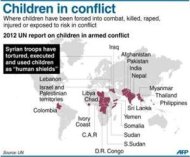 Syria protesters (REUTERS/Shaam News Network/Handout)
Syria protesters (REUTERS/Shaam News Network/Handout)
It took 15 months, more than 14,000 lives, and shots fired at United Nations monitors investigating a massacre before the U.N. called Syria's conflict a civil war.
The acknowledgment came June 12 from the U.N. Under-Secretary-General for Peacekeeping Operations Herve Ladsous. Of course, unless the words "Syrian civil war" comes from the International Committee of the Red Cross, the Geneva Conventions don't kick in?although ICRC has described the situation as "deteriorating sharply."
For most observers, the death toll and the U.N.'s report of children being used as human shields already confirms Syria is, if not in civil war, has devolved into a kind of genocide. Of all the nations swept up in the Arab Spring, how did Syria's crisis reach these proportions? And what is the truth behind the Houla massacre, which many call a turning point in the bloodshed? Some thinking on Syria:
 Children in conflict (AFP)
Children in conflict (AFP)
[Related: Syria conflict now a civil war, U.N. peacekeeping chief says]
 Syria bombing (AFP)A quick Syria history: Syria's about the size of North Dakota, but with 30 times the population at 22 million. Bordered by Iraq, Turkey, Jordan, and Lebanon, the nation traces its history to Neolithic times. The area enjoyed wealth and prestige during the Roman era, before being devastated by Mongol invasions beginning in the 13th century. Later part of the Ottoman Empire for centuries, the country fell to France following World War I. Independence was gained in 1944, but coups defined modern governmental politics until 1970, when Baath Party leader Hafez al-Assad gained control and used brutal means to reinforce it, including the Hama massacre in which up to 45,000 people were killed or disappeared. His son Bashar al-Assad succeeded in 2000.
Syria bombing (AFP)A quick Syria history: Syria's about the size of North Dakota, but with 30 times the population at 22 million. Bordered by Iraq, Turkey, Jordan, and Lebanon, the nation traces its history to Neolithic times. The area enjoyed wealth and prestige during the Roman era, before being devastated by Mongol invasions beginning in the 13th century. Later part of the Ottoman Empire for centuries, the country fell to France following World War I. Independence was gained in 1944, but coups defined modern governmental politics until 1970, when Baath Party leader Hafez al-Assad gained control and used brutal means to reinforce it, including the Hama massacre in which up to 45,000 people were killed or disappeared. His son Bashar al-Assad succeeded in 2000.
 President Bashar al-Assad (AFP)Arab Spring: For Westerners, Arab Spring seemingly erupted when a fruit-and-vegetable cart vendor immolated himself to protest corruption, and this act spawned bloody protests that upended entrenched regimes in Tunisia, Egypt, and Libya. Unlike other leaders, al-Assad, trained as an ophthalmologist, was supposed to be the reformist. He was certainly media-savvy, paired with a forward-looking, British-educated, glamorous wife who attracted magazine profiles. He used foreign investments that modernized Syria, but never lifted the state of emergency imposed in 1963. In March 2011, his cabinet resigned in the face of protests, and he suspended the state of emergency. Since then, however, brutality has reigned.
President Bashar al-Assad (AFP)Arab Spring: For Westerners, Arab Spring seemingly erupted when a fruit-and-vegetable cart vendor immolated himself to protest corruption, and this act spawned bloody protests that upended entrenched regimes in Tunisia, Egypt, and Libya. Unlike other leaders, al-Assad, trained as an ophthalmologist, was supposed to be the reformist. He was certainly media-savvy, paired with a forward-looking, British-educated, glamorous wife who attracted magazine profiles. He used foreign investments that modernized Syria, but never lifted the state of emergency imposed in 1963. In March 2011, his cabinet resigned in the face of protests, and he suspended the state of emergency. Since then, however, brutality has reigned.
The Saddam Hussein party: Al-Assad belongs to the socialist Ba'ath party and minority Alawi sect. Andrew Tabler, author of "In the Lion's Den: An Eyewitness Account of Washington's Battle With Syria," describes his regime as similar to Saddam Hussein's.
[I]t's the same kind of regime. In Iraq, you had the Sunnis, a minority in that country, using Ba'athism to rule over the majority Shia population and the Kurds, as well. In Syria, instead of Sunnis, you have Alawites, who are about 12 percent of the population, ruling over the majority Sunni population, which is about 75 percent.
...An Alawite is a heterodox offshoot of Shia Islam. The mainline Shia, like those in Iran and Hezbollah, are what they call twelvers, waiting for the 12th imam. Alawites are eleveners. They? it?they primarily come from the Syrian coast. They have been regarded by many Muslims, including Sunnis, as apostates and were treated horribly under Ottoman rule.
And so since the 1960s, when Hafez al-Assad finally came to power, Bashar al-Assad's father, in 1970, they've run roughshod over Syria. And so that's what makes the current insurgency, civil unarmed insurgency against the Assad regime, take on a very sectarian nature. You have Sunnis trying to displace an Alawite regime. (June 11, NPR)
cheesecake recipe leona lewis carlos beltran air jordan 11 concord unemployment extension the thin man republic wireless





No comments:
Post a Comment
Note: Only a member of this blog may post a comment.